THE INVENTION OF THE RADIO
![]()
GUGLIELMO MARCONI was born in Bologna in April the 25th, 1874. His father was named Joseph and his mother, Annie Jamieson, Protestant, was the second wife of his father. From his mother he inherited tenaciousness and perseverance, and knowledge of English language; from his father a strong will and business skill. When seven years old he entered the Institute Cavallero in Florence, and in 1885 the Institute National in Livorno, where meanwhile the family had moved. In Livorno GUGLIELMO acquired also a religious culture in the local Valdese church, where he was "confirmed" in 1882; in fact her mother before marrying laid down the condition that her sons would have been educated as Protestants. GUGLIELMO itself will marry as first wife a Protestant: Beatrice O'Brien.
Self-taught person, when he was just eighteen, felt the growth of an irresistible vocation inside for physics and electricity.
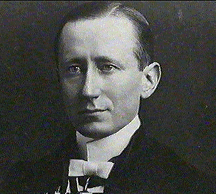
Guglielmo Morconi (1874-1937)
|
Pupil in Livorno of professors Vincenzo Rosa and Giotto Bizzarrini, he acquired a more rigorously scientific way of thinking in a crucial moment for the direction of his studies. He knew well the ideas and theories of MAXWELL, the experiments of HERTZ, RIGHI, CALZECCHI-ONESTI, BRANLY. During the summer 1894, during his family vacations on the mountains near Biella (in the surroundings of Turin) Young GUGLIELMO could meditate on Hertz's experiments, and had the idea to use the hertzian waves to communicate.
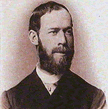
Hertz |
This was his marvelous intuition, never thought of before by anybody. During the following Fall, in the villa in Pontecchio near Bologna, the twenty-years-old boy transformed the granary in his laboratory, working night and day among rolls of copper wire, brass spheres, Ruhmkorff coils, Morse keys and electric bells, realizing the first elementary radio sets. The first weak signals could reach few hundred meters: from the window of the granary where was placed the transmitter to the hill at the end of the garden where was the receiver, the three points of the letter S traveled the space, reaching the destination, and the farmer waved his handkerchief to show the successful reception. But MARCONI wanted to get over the obstacles of the ground and connect two reciprocally invisible points. He took the receiver to the other side of the hill, where Mignani with his gun waited for the ring to sound three times. From the granary MARCONI pushed three times the key of the transmitter and heard the answer of a distant gunshot: electromagnetic waves had overtaken the obstacle, radio communications where now possible! It was the month of April 1895. For this experiments MARCONI used the oscillators of HERTZ and RIGHI, but the waves where too weak to go too far. He overcame the difficulties connecting to the oscillator an antenna and a ground, thus obtaining more power.
In 1886 he obtained his first patent, which he presented to the Italian government of that time, offer that wasn't even considered. His mother, understanding the importance of the invention, wrote to her parents in England, who advised her to send him to London, where it could have been easier to find the money necessary to develop the invention. On February 2, 1896 MARCONI left for England where, with the help of engineer DAVID JAMESON, his mother's cousin, he was introduced to the director of the Post and Telephones company, Sir WILLIAM PREECE, who became an enthusiastic supporter. On July 27 he performed his first official experiment from the terrace of the Post Office to the Salisbury plain. Other transmissions where performed successfully across the Bristol channel, between Penarth and Weston. In 1897 MARCONI founded the first organization for the commercial development of his invention and in July of the same year, invited by the Italian government, came back to Italy and performed in La Spezia a communication between the arsenal and the battleship San Martino, surpassing the distance of 18 Km. Back in England, on July 20 MARCONI founded the WIRELESS TELEGRAPH TRADING SIGNAL CO. LTD. In November was built the first MARCONI fixed station in Needless in the Isle of Wight, and were performed the first connections with Bournmouth 23 Km. away.
In may 1898 MARCONI realized the first equipment's with tuning circuits to guarantee the independence of simultaneous communications between more stations (the future and famous patent 7777), and in July of the same year he carried out the first journalistic radiotelegraphic service for the Daily Express during the Royal Yacht Club Regatta, reporting from the deck of the yacht Flying Hontress to Kingstown, which was connected via telephone to Dublin. On august the 26th for the first time a help signal was sent from a lighthouse boat using wireless telegraphy; on march 3 was made the first rescue of the shipwreck of a boat, the Mathens, using radiotelegraphy. On day 27 of the same month MARCONI achieved the telegraphic connection between England and France, from Wimereux near Boulogne-sur-Mer to South Foreland near Dover, distant 32 miles. In September MARCONI went to the United States where he carried out the connection between the cruisers New York and Massachusetts of U.S. Navy. In this period he improved his equipment to overcome the difficulties in order to obtain more distant connections, to get over the mountains and most of all the curve of the earth surface, which scientists considered insuperable to the radio waves. It is the year 1900: the WIRELESS TELEGRAPH TRADING SIGNAL CO. LTD. changes its name into MARCONI WIRELESS TELEGRAPH CO. and on April 26 MARCONI obtains the historical English patent n. 7777 on his first tuning equipment. In October he ended building the Poldhu station in Cornwall, the most powerful telegraph station ever built until then. On November 26, 1901 MARCONI with his two assistants PAGET and KEMPT embarked in Liverpool and reached St. John's in Terranova, where he built another radio station: on December the 12 around 12.30, local time, MARCONI received three weak signals corresponding to letter S in MORSE code. For the first time in the world electromagnetic waves had crossed an ocean.
On February 22 MARCONI embarked on the boat Philadelphus bound to America to build a big radio station in Glace Bay in Nova Scotia, upon invitation of the Canadian government. During the trip the scientist made important experiments discovering the harmful influence of solar radiation on transmissions, and, as he saw that the coherer did not meet the increasing needs of stability of reception, created a new kind of detector. This new device will be the Magnetic Detector, which will be patented on June 25, 1902. He will use it for the first time on board of the Italian battleship Carlo Alberto, at his disposal from the Italian government for the famous radiotelegraphic campaign from Naples to Kronstadt in Russia, always keeping contact with Poldhu station.
In the month of October of the same yearthe boat was bound to Canada to Glace Bay, where MARCONI started the experiments to communicate across the Atlantic ocean from the other side, that is from America to Europe; Poldhu station worked as a receiver. For a long time every communication was impossible and from Poldhu via cable line the only message was "standard", that is "we haven't received anything". At last on December 15 the message received from Poldhu changed in "greentime", that is "we have received some signals", while on day 18 the reception became intelligible, and transmission was sure on both directions: the first transoceanic bilateral transmission was over. On September 1903 during the boat trip from England to United States on board of steamboat Lucania MARCONI established the first press agency between Europe and America, starting regular printing of newspapers on board during the trip across the Atlantic.
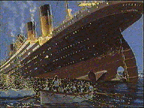 It
was wireless transmissions from the stricken Titanic which brought
other vessels from far off, saving 711 lives. What is less well
known is that the Titanic's transmissions could have saved many
more lives as the only surviving officer from the great liner
recounts. It
was wireless transmissions from the stricken Titanic which brought
other vessels from far off, saving 711 lives. What is less well
known is that the Titanic's transmissions could have saved many
more lives as the only surviving officer from the great liner
recounts. |
In 1904 MARCONI built the rotating oscillator discovered the directive properties of horizontal antennas, and started to use FLEMING thermionic valves. In 1905 he patented his directive horizontal antennas, which permitted a tremendous increase of the strength of received signals.
On December 10, 1909 GUGLIELMO MARCONI was awarded the Nobel prize for Physics.
In 1912 MARCONI invented a new way to generate continuous waves, called "multiple sparks system", a smart intermediate point between the previous spark instruments and those with continuous wave. In 1914, after the improvement of radiotelephonic instruments using triode thermionic valves, he experimented successfully a regular radiotelephonic service: it was the birth of radiophony. At the outburst of World War First he enrolled in the Italian Army as an officer. In march 1916, following some problems in using long waves during military operations, MARCONI started realizing the first VHF radios, opening thus a wider horizon to the development of radio communications. In 1916 he bought the boat Elettra, which became his personal laboratory, where he attended his studies and his researches. Knowing the peculiar properties of short waves, in 1922 MARCONI recommended their use instead of long waves, and between June and July 1923 he performed very important experiences between Poldhu and the Elettra, moored in the islands of Palo Verde (nearly 4000 Km.) , obtaining such results that led him to try even farther. In 1924 MARCONI built numerous short wave stations, in the 30-60 Mhz band, for British government, and on may 30 of that same year took place the first regular transmission of human voice between England (Poldhu) and Australia (Sydney).
On October the 5th the Italian Ministry of Communications authorized the "Italian Radiophone Union Society" to start radio auditions in Italy. On June 15 MARCONI married his second wife, the countess Maria Cristina Bozzi Scali (disappeared recently), and on January the 1st., 1928 he was named president of C.N.R. (National Research Council). On march 26, 1930, from aboard the Elettra moored in the harbor of Geneva, he sent a signal that, after covering 14.000 miles, lighted Sydney town hall. In September the 17 he was named President of Italian Royal Academy. Because of the start of regular radio services all throughout the world, the air was becoming more and more jammed with signals; MARCONI then opened new horizons to the radio, improving the reflecting radios, which worked on frequencies below one meter. On February 12, 1931 MARCONI, in the presence of Pope Pius IX, inaugurated the new Vatican Radio Station, and on September the 13 of that same year, from his office in Rome, MARCONI lighted up the statue of the Redeemer in Rio de Janeiro, via the Coltano repeater. In this period MARCONI demonstrated the possibility of using microwaves communicating between Santa Margherita Ligure and Levanto (36 Km.). In 1932 he built the permanent radiotelegraphic connection between the Vatican and Castle Gandolfo (summer seat of the Pontifex). In the days 2-11 of august of that year he made important experiments between Rocca di Papa and the Elettra until the distance of 224 Km. (127 Km. beyond optical reach) and between Rocca di Papa and Senapro of Capo Lipari in Sardinia, at the distance of 269 Km., using a wavelength of 57 cm!
In July the 26, 1934 MARCONI established the radiotelegraphic connection between the Elettra and the radio beacon in Sestri Levante with a wavelength of 63 cm., demonstrating how a ship could, in case of fog and in total blindness, find safely the entrance of a harbor. In march 1935 on the via Aurelia he performed some distant search experiments which would eventually lead to the invention of radar. Together with microwaves, he studied also television, foreseeing the future, and started research on therapeutic use of radio waves (Marconitherapy).
GUGLIELMO MARCONI died of a heart attack in Rome on July 20, 1937. To remember his name, his multiform activity as researcher, inventor, experimenter, scientist and scholar, radios all around the world observed a long minute of silent regret.
His example, his precious work, his way to conduct experiments and trials with both exactitude and scientific method, his stubbornness to lead the tests until the deep and complete understanding of the phenomenon, his devotion, his firmness, his enthusiasm, his commitment are an inestimable heritage.
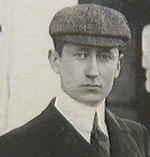
Marconi |
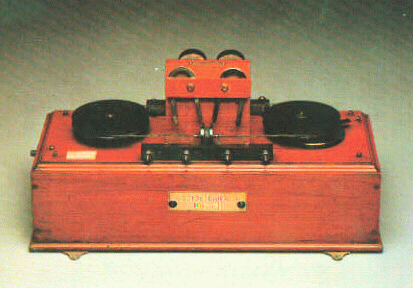 |
Magnetic detector Year 1903. This detector was conceived by Marconi in 1902 and used to receive radio signal on board of the Royal Ship CARLO ALBERTO. |
|
MARCONI |
Dr. Ernest F. W. Alexanderson
1878 - 1975
Dr. Ernest Alexanderson, the engineer whose high-frequency alternator gave America its start in the field of radio communications, was born on January 25, 1878 in Upsala, Sweden. He developed an early interest in electrical engineering that was stimulated by a year of technical work at the University of Lund in 1896. He then spent three years at the Royal Institute of Technology in Stockholm, from which he was graduated in 1890 as an electrical-mechanical engineer. This was followed by a year of postgraduate work at the Technical University in Berlin, Germany.

When a copy of Alternating Current Phenomena by Dr. Charles P. Steinmetz, General Electric's mathematics genius, fell into Dr. Alexanderson's hands, it made such an impression on him that he decided to move to America and seek work with the author. In 1901 he arrived in the U.S. and visited Steinmetz in Schenectady, NY. In 1902, on the latter's recommendation, GE gave him a drafting job. The following year, he took GE's Test Engineering Course, and in 1904 he became a member of the engineering staff designating generators under the direction of Steinmetz.
In those days, radio was an affair only of dots and dashes transmitted by inefficient crashing spark machines. Then, in 1904, GE was asked by Professor Reginald A. Fessenden, a pioneer in radio experimentation, if the company could build a high-frequency machine that would operate at high speeds and produce a continuous wave transmission.
The assignment was turned over to Dr. Alexanderson. Although the usual generator in those days operated at 60 cycles, Prof. Fessenden wanted one that would operate on at least 100,000 cycles, an idea considered fantastic by most engineers. After two years of experimentation, Dr. Alexanderson finally constructed a two-kilowatt, 100,000 cycle machine that he felt met Fessenden's specifications. It was installed in the Fessenden station at Brant Rock, Massachusetts, and on Christmas Eve 1906, it enabled that station to transmit the first voice broadcast in history.
When Steinmetz organized a Consulting Engineering Department in 1910, Dr. Alexanderson became a member of the group. Meanwhile, news of the alternator had reached the ears of Guglielmo Marconi, the "father" of radio, and in 1915 he came from England to visit GE and talk with Dr. Alexanderson in Schenectady. He arranged to have a 50-kilowatt and then 200-kilowatt Alexanderson alternator installed in his transatlantic Marconi Company station in New Brunswick, NJ. The latter was put to its first important practical test in 1918: the transmission of President Woodrow Wilson's ultimatum to Germany, which brought the war to a close.
In 1918, Dr. Alexanderson became the head of GE's newly organized Radio Engineering Department (renamed Radio Consulting Department in 1922). The next year, Marconi renewed negotiations, first instituted early in the war, for exclusive rights to the alternator. It was then that President Wilson appealed to GE not to sell and instead to help organize an American company to use the alternator. This led to the formation of the Radio Corporation of America, with Dr. Alexanderson becoming its chief engineer.
Meanwhile, Dr. Alexanderson's inventive genius had been hard at work. Among his notable radio developments were the magnetic amplifier, the electric amplifier, the multiple tuned antenna, the anti-static receiving antenna, and the directional transmitting antenna. He also devised radio altimeters, and his studies in the polarization of radio waves made possible effective radio direction finders.
From 1919 to 1924, Dr. Alexanderson divided his time between General Electric and RCA. In the next few years, he performed pioneering work in television and the transmission of pictures by radio. Using a perforated scanning disk and high-frequency neon lamps, he staged in Schenectady the first home theater demonstrations. The first home television reception took place in 1927 in his home, and a public demonstration was held the following year.
The theater demonstration, witnessed by science writers from all over the country, took place on May 22, 1930, in Proctor's Theater in Schenectady. The theater orchestra was led by the image of a conductor on a seven-foot screen which also carried the faces of other performers a mile away in a GE laboratory.
With GE's withdrawal from the affairs of the Radio Corporation of America in 1933, Dr. Alexanderson devoted himself at GE to the power applications of the electronic science, such as power transmission with direct current. With the broadening scope of its activities, his Radio Consulting Department had become the Consulting Engineering Department in 1928 and finally the Consulting Engineering Laboratory in 1933. In 1945, the Consulting Engineering Laboratory was merged with GE's General Engineering Laboratory to form the General Engineering and Consulting Laboratory. He served as a consulting engineer on the staff of the new organization until his retirement in 1948. During his 46-year GE career, he had received a total of 322 patents, or nearly one every eleven weeks. He died in 1975 at the age of 97.